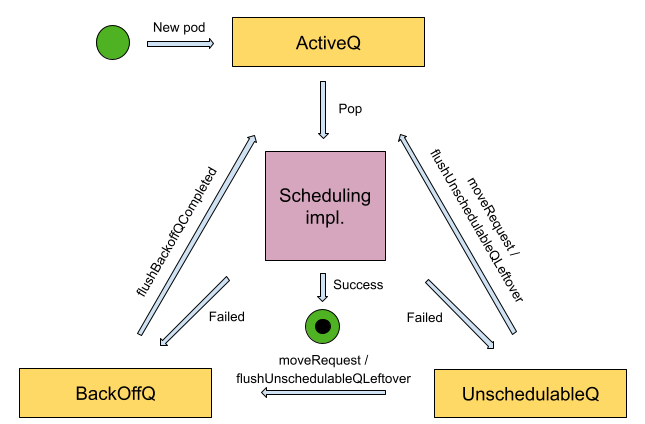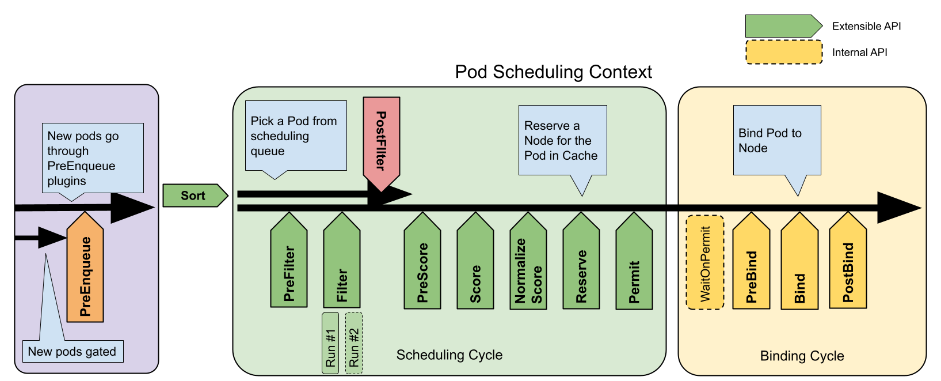Kubernetes:kube-scheduler 源码分析
0. 前言
[译] kubernetes:kube-scheduler 调度器代码结构概述 介绍了 kube-scheduler 的代码结构。本文围绕代码结构,从源码角度出发,分析 kube-scheduler 的调度逻辑。
1. 启动 kube-scheduler
kube-scheduler 使用 Cobra 框架初始化参数,配置和应用。
// kubernetes/cmd/kube-scheduler/scheduler.go
func main() {
// 启动 kube-scheduler 入口
command := app.NewSchedulerCommand()
...
}
// kubernetes/cmd/kube-scheduler/app/server.go
func NewSchedulerCommand(registryOptions ...Option) *cobra.Command {
// 创建 kube-scheduler 选项
opts := options.NewOptions()
cmd := &cobra.Command{
Use: "kube-scheduler",
...
RunE: func(cmd *cobra.Command, args []string) error {
return runCommand(cmd, opts, registryOptions...)
},
...
}
...
}
// 运行 kube-scheduler
func runCommand(cmd *cobra.Command, opts *options.Options, registryOptions ...Option) error {
...
// 创建 kube-scheduler 配置 cc
// 创建 kube-scheduler 实例 sched
cc, sched, err := Setup(ctx, opts, registryOptions...)
if err != nil {
return err
}
...
return Run(ctx, cc, sched)
}
从启动命令来看,这里重点关注的是 Setup 函数。在该函数内,创建 kube-scheduler 配置 cc 和调度器实例 sched。
func Setup(ctx context.Context, opts *options.Options, outOfTreeRegistryOptions ...Option) (*schedulerserverconfig.CompletedConfig, *scheduler.Scheduler, error) {
...
// 验证选项
if errs := opts.Validate(); len(errs) > 0 {
return nil, nil, utilerrors.NewAggregate(errs)
}
// 根据选项创建配置 c
c, err := opts.Config(ctx)
if err != nil {
return nil, nil, err
}
// 补充配置为完整配置
cc := c.Complete()
// 外部注册插件
outOfTreeRegistry := make(runtime.Registry)
for _, option := range outOfTreeRegistryOptions {
if err := option(outOfTreeRegistry); err != nil {
return nil, nil, err
}
}
...
// 创建调度器实例 sched
sched, err := scheduler.New(ctx,
cc.Client,
cc.InformerFactory,
cc.DynInformerFactory,
recorderFactory,
scheduler.WithComponentConfigVersion(cc.ComponentConfig.TypeMeta.APIVersion),
scheduler.WithKubeConfig(cc.KubeConfig),
scheduler.WithProfiles(cc.ComponentConfig.Profiles...),
scheduler.WithPercentageOfNodesToScore(cc.ComponentConfig.PercentageOfNodesToScore),
scheduler.WithFrameworkOutOfTreeRegistry(outOfTreeRegistry),
scheduler.WithPodMaxBackoffSeconds(cc.ComponentConfig.PodMaxBackoffSeconds),
scheduler.WithPodInitialBackoffSeconds(cc.ComponentConfig.PodInitialBackoffSeconds),
scheduler.WithPodMaxInUnschedulablePodsDuration(cc.PodMaxInUnschedulablePodsDuration),
scheduler.WithExtenders(cc.ComponentConfig.Extenders...),
scheduler.WithParallelism(cc.ComponentConfig.Parallelism),
scheduler.WithBuildFrameworkCapturer(func(profile kubeschedulerconfig.KubeSchedulerProfile) {
// Profiles are processed during Framework instantiation to set default plugins and configurations. Capturing them for logging
completedProfiles = append(completedProfiles, profile)
}),
)
...
return &cc, sched, nil
}
函数 scheduler.New 创建调度器实例 sched,进入函数内查看实例是如何创建的。
func New(ctx context.Context,
client clientset.Interface,
informerFactory informers.SharedInformerFactory,
dynInformerFactory dynamicinformer.DynamicSharedInformerFactory,
recorderFactory profile.RecorderFactory,
opts ...Option) (*Scheduler, error) {
...
// 注册内置插件
registry := frameworkplugins.NewInTreeRegistry()
// merge 内置插件和外部注册插件
if err := registry.Merge(options.frameworkOutOfTreeRegistry); err != nil {
return nil, err
}
// 注册指标
metrics.Register()
// 注册外部扩展器
extenders, err := buildExtenders(logger, options.extenders, options.profiles)
if err != nil {
return nil, fmt.Errorf("couldn't build extenders: %w", err)
}
// 实例化 podLister 负责监控 pod 变化
podLister := informerFactory.Core().V1().Pods().Lister()
// 实例化 nodeLister 负责监控 node 变化
nodeLister := informerFactory.Core().V1().Nodes().Lister()
// 创建 snapshot,snapshot 作为缓存存在
snapshot := internalcache.NewEmptySnapshot()
...
// 创建 profiles,profiles 中存储的是调度器框架
profiles, err := profile.NewMap(ctx, options.profiles, registry, recorderFactory,
frameworkruntime.WithComponentConfigVersion(options.componentConfigVersion),
frameworkruntime.WithClientSet(client),
frameworkruntime.WithKubeConfig(options.kubeConfig),
frameworkruntime.WithInformerFactory(informerFactory),
frameworkruntime.WithSnapshotSharedLister(snapshot),
frameworkruntime.WithCaptureProfile(frameworkruntime.CaptureProfile(options.frameworkCapturer)),
frameworkruntime.WithParallelism(int(options.parallelism)),
frameworkruntime.WithExtenders(extenders),
frameworkruntime.WithMetricsRecorder(metricsRecorder),
)
// 创建 preEnqueuePlugin 插件
preEnqueuePluginMap := make(map[string][]framework.PreEnqueuePlugin)
...
// 创建优先级队列 podQueue
podQueue := internalqueue.NewSchedulingQueue(
profiles[options.profiles[0].SchedulerName].QueueSortFunc(),
informerFactory,
internalqueue.WithPodInitialBackoffDuration(time.Duration(options.podInitialBackoffSeconds)*time.Second),
internalqueue.WithPodMaxBackoffDuration(time.Duration(options.podMaxBackoffSeconds)*time.Second),
internalqueue.WithPodLister(podLister),
internalqueue.WithPodMaxInUnschedulablePodsDuration(options.podMaxInUnschedulablePodsDuration),
internalqueue.WithPreEnqueuePluginMap(preEnqueuePluginMap),
internalqueue.WithQueueingHintMapPerProfile(queueingHintsPerProfile),
internalqueue.WithPluginMetricsSamplePercent(pluginMetricsSamplePercent),
internalqueue.WithMetricsRecorder(*metricsRecorder),
)
...
// 创建调度器缓存
schedulerCache := internalcache.New(ctx, durationToExpireAssumedPod)
...
// 实例化调度器
sched := &Scheduler{
Cache: schedulerCache,
client: client,
nodeInfoSnapshot: snapshot,
percentageOfNodesToScore: options.percentageOfNodesToScore,
Extenders: extenders,
StopEverything: stopEverything,
SchedulingQueue: podQueue,
Profiles: profiles,
logger: logger,
}
// 将队列的 Pop 方法赋值给 sched.NextPod
sched.NextPod = podQueue.Pop
...
// 添加 Event 回调 handler
if err = addAllEventHandlers(sched, informerFactory, dynInformerFactory, unionedGVKs(queueingHintsPerProfile)); err != nil {
return nil, fmt.Errorf("adding event handlers: %w", err)
}
return sched, nil
}
scheduler.New 创建了 snapshot, eventHandler, profiles(framework) 和 cache 等对象,结合着调度框架将它们关联起来会更清晰。

2. 运行 kube-scheduler
创建完各个对象之后,接下来运行 kube-scheduler 将各个对象关联起来运行。
func Run(ctx context.Context, cc *schedulerserverconfig.CompletedConfig, sched *scheduler.Scheduler) error {
...
// 选举 leader
waitingForLeader := make(chan struct{})
isLeader := func() bool {
select {
case _, ok := <-waitingForLeader:
// if channel is closed, we are leading
return !ok
default:
// channel is open, we are waiting for a leader
return false
}
}
...
// 运行 informer
startInformersAndWaitForSync := func(ctx context.Context) {
// Start all informers.
cc.InformerFactory.Start(ctx.Done())
// DynInformerFactory can be nil in tests.
if cc.DynInformerFactory != nil {
cc.DynInformerFactory.Start(ctx.Done())
}
// Wait for all caches to sync before scheduling.
cc.InformerFactory.WaitForCacheSync(ctx.Done())
// DynInformerFactory can be nil in tests.
if cc.DynInformerFactory != nil {
cc.DynInformerFactory.WaitForCacheSync(ctx.Done())
}
// Wait for all handlers to sync (all items in the initial list delivered) before scheduling.
if err := sched.WaitForHandlersSync(ctx); err != nil {
logger.Error(err, "waiting for handlers to sync")
}
logger.V(3).Info("Handlers synced")
}
if !cc.ComponentConfig.DelayCacheUntilActive || cc.LeaderElection == nil {
startInformersAndWaitForSync(ctx)
}
// leader 节点运行调度逻辑,暂略
if cc.LeaderElection != nil {
...
}
close(waitingForLeader)
sched.Run(ctx)
return fmt.Errorf("finished without leader elect")
}
Run 函数内包含三部分处理:
- 选举 leader 节点。如果是单节点,则跳过选举。
- 运行 informer,负责监控 pod 和 node 变化。
- 运行调度器
进入 sched.Run 查看调度器是如何运行的。
func (sched *Scheduler) Run(ctx context.Context) {
...
// 从队列中去需要调度的 pod
sched.SchedulingQueue.Run(logger)
// 调度 pod
go wait.UntilWithContext(ctx, sched.scheduleOne, 0)
<-ctx.Done()
...
}
sched.Run 主要做了两件事。从优先级队列中取用于调度的 pod,然后通过 sched.scheduleOne 调度该 pod。
首先,看取调度 pod 的过程,如下。
func (p *PriorityQueue) Run(logger klog.Logger) {
go wait.Until(func() {
p.flushBackoffQCompleted(logger)
}, 1.0*time.Second, p.stop)
go wait.Until(func() {
p.flushUnschedulablePodsLeftover(logger)
}, 30*time.Second, p.stop)
}
优先级队列由 ActiveQ,BackoffQ 和 UnschedulableQ 组成,其逻辑关系如下。

在 PriorityQueue.Run 中启动两个 goroutine 分别运行 p.flushBackoffQCompleted 和 p.flushUnschedulablePodsLeftover 方法。p.flushBackoffQCompleted 将处于 BackOffQ 的 pod 移到 ActiveQ。p.flushUnschedulablePodsLeftover 将 UnschedulableQ 的 pod 移到 ActiveQ 或者 BackOffQ。详细取调度 pod 的逻辑可查看 kube-scheduler 调度队列。
接着,进入 sched.scheduleOne 查看 pod 是怎么调度的。
func (sched *Scheduler) scheduleOne(ctx context.Context) {
...
// 获取需要调度的 pod
podInfo, err := sched.NextPod(logger)
...
// 进入调度循环调度 pod
scheduleResult, assumedPodInfo, status := sched.schedulingCycle(schedulingCycleCtx, state, fwk, podInfo, start, podsToActivate)
if !status.IsSuccess() {
sched.FailureHandler(schedulingCycleCtx, fwk, assumedPodInfo, status, scheduleResult.nominatingInfo, start)
return
}
// 进入绑定循环绑定 pod
go func() {
...
status := sched.bindingCycle(bindingCycleCtx, state, fwk, scheduleResult, assumedPodInfo, start, podsToActivate)
...
}()
}
sched.scheduleOne 主要包括三部分:获取需要调度的 pod,进入调度循环调度 pod 和进入绑定循环绑定 pod。其逻辑结构如下。

进一步,查看每一部分的源码。
2.1 sched.NextPod 获取需要调度的 pod
func (p *PriorityQueue) Pop(logger klog.Logger) (*framework.QueuedPodInfo, error) {
...
for p.activeQ.Len() == 0 {
if p.closed {
logger.V(2).Info("Scheduling queue is closed")
return nil, nil
}
// 如果 activeQ 没有 pod 的话,阻塞等待
p.cond.Wait()
}
// 从 activeQ 中取 pod
obj, err := p.activeQ.Pop()
if err != nil {
return nil, err
}
pInfo := obj.(*framework.QueuedPodInfo)
...
return pInfo, nil
}
sched.NextPod 的逻辑主要是看 activeQ 队列中有没有 pod,如果有的话,取 pod 调度。如果没有的话,阻塞等待,直到 activeQ 中有 pod。
2.2 sched.schedulingCycle 调度 pod
func (sched *Scheduler) schedulingCycle(
ctx context.Context,
state *framework.CycleState,
fwk framework.Framework,
podInfo *framework.QueuedPodInfo,
start time.Time,
podsToActivate *framework.PodsToActivate,
) (ScheduleResult, *framework.QueuedPodInfo, *framework.Status) {
...
// 调度 Pod
scheduleResult, err := sched.SchedulePod(ctx, fwk, state, pod)
...
assumedPodInfo := podInfo.DeepCopy()
assumedPod := assumedPodInfo.Pod
err = sched.assume(logger, assumedPod, scheduleResult.SuggestedHost)
...
// 运行 Reserve 插件的 Reserve 方法
if sts := fwk.RunReservePluginsReserve(ctx, state, assumedPod, scheduleResult.SuggestedHost); !sts.IsSuccess() {
...
}
// 运行 Permit 插件
runPermitStatus := fwk.RunPermitPlugins(ctx, state, assumedPod, scheduleResult.SuggestedHost)
if !runPermitStatus.IsWait() && !runPermitStatus.IsSuccess() {
...
}
...
return scheduleResult, assumedPodInfo, nil
}
sched.schedulingCycle 包含几个步骤:sched.SchedulePod 调度 Pod,将调度的还未绑定的 Pod 作为 assumedPod 添加到缓存,运行 Reserve 插件和 Permit 插件。
首先,看 sched.SchedulePod 是怎么调度 Pod 的。
func (sched *Scheduler) schedulePod(ctx context.Context, fwk framework.Framework, state *framework.CycleState, pod *v1.Pod) (result ScheduleResult, err error) {
feasibleNodes, diagnosis, err := sched.findNodesThatFitPod(ctx, fwk, state, pod)
if err != nil {
return result, err
}
...
}
在 sched.SchedulePod 中,sched.findNodesThatFitPod 为 Pod 寻找合适的节点。
// kubernetes/pkg/scheduler/schedule_one.go
func (sched *Scheduler) findNodesThatFitPod(ctx context.Context, fwk framework.Framework, state *framework.CycleState, pod *v1.Pod) ([]*framework.NodeInfo, framework.Diagnosis, error) {
...
// 从 snapshot 中取所有节点
allNodes, err := sched.nodeInfoSnapshot.NodeInfos().List()
if err != nil {
return nil, diagnosis, err
}
preRes, s := fwk.RunPreFilterPlugins(ctx, state, pod)
if !s.IsSuccess() {
...
}
...
// 寻找 pod 可调用的节点
feasibleNodes, err := sched.findNodesThatPassFilters(ctx, fwk, state, pod, &diagnosis, nodes)
...
}
// kubernetes/pkg/scheduler/schedule_one.go
func (sched *Scheduler) findNodesThatPassFilters(
ctx context.Context,
fwk framework.Framework,
state *framework.CycleState,
pod *v1.Pod,
diagnosis *framework.Diagnosis,
nodes []*framework.NodeInfo) ([]*framework.NodeInfo, error) {
...
checkNode := func(i int) {
...
status := fwk.RunFilterPluginsWithNominatedPods(ctx, state, pod, nodeInfo)
}
...
}
// kubernetes/pkg/scheduler/framework/runtime/framework.go
func (f *frameworkImpl) RunFilterPluginsWithNominatedPods(ctx context.Context, state *framework.CycleState, pod *v1.Pod, info *framework.NodeInfo) *framework.Status {
...
for i := 0; i < 2; i++ {
...
// 运行 Filter 插件
status = f.RunFilterPlugins(ctx, stateToUse, pod, nodeInfoToUse)
if !status.IsSuccess() && !status.IsRejected() {
return status
}
}
return status
}
sched.findNodesThatFitPod 运行 Filter 插件获取可用的节点 feasibleNodes。接着,如果可用的节点只有一个,则返回调度结果。如果有多个节点则运行 priority 插件寻找最合适的节点作为调度节点。逻辑如下。
func (sched *Scheduler) schedulePod(ctx context.Context, fwk framework.Framework, state *framework.CycleState, pod *v1.Pod) (result ScheduleResult, err error) {
...
feasibleNodes, diagnosis, err := sched.findNodesThatFitPod(ctx, fwk, state, pod)
if err != nil {
return result, err
}
...
if len(feasibleNodes) == 1 {
return ScheduleResult{
SuggestedHost: feasibleNodes[0].Node().Name,
EvaluatedNodes: 1 + len(diagnosis.NodeToStatusMap),
FeasibleNodes: 1,
}, nil
}
priorityList, err := sched.prioritizeNodes(ctx, fwk, state, pod, feasibleNodes)
if err != nil {
return result, err
}
host, _, err := selectHost(priorityList, numberOfHighestScoredNodesToReport)
...
return ScheduleResult{
SuggestedHost: host,
EvaluatedNodes: len(feasibleNodes) + len(diagnosis.NodeToStatusMap),
FeasibleNodes: len(feasibleNodes),
}, err
获得调度结果 scheduleResult 后,在 sched.schedulingCycle 中的 sched.assume 将 assumePod 的 NodeName 更新为调度的节点 host,并且将 assumePod 添加到缓存中。缓存允许运行假定的操作,该操作将 Pod 临时存储在缓存中,使得 Pod 看起来像已经在快照的所有消费者的指定节点上运行那样。假定操作忽视了 kube-apiserver 和 Pod 实际更新的时间,从而增加调度器的吞吐量。
func (sched *Scheduler) assume(logger klog.Logger, assumed *v1.Pod, host string) error {
assumed.Spec.NodeName = host
if err := sched.Cache.AssumePod(logger, assumed); err != nil {
logger.Error(err, "Scheduler cache AssumePod failed")
return err
}
...
return nil
}
// kubernetes/pkg/scheduler/internal/cache/cache.go
func (cache *cacheImpl) AssumePod(logger klog.Logger, pod *v1.Pod) error {
...
return cache.addPod(logger, pod, true)
}
继续如 调度框架 所示,在 sched.schedulingCycle 中执行 Reserve 和 Permit 插件,插件执行通过后调度周期返回 Pod 的调度结果。
接着,进入绑定周期。
2.3 绑定周期
绑定周期是一个异步的 goroutine,负责将调度到节点的 Pod 发送给 kube-apiserver。进入绑定周期查看绑定逻辑的实现。
// kubernetes/pkg/scheduler/schedule_one.go
func (sched *Scheduler) scheduleOne(ctx context.Context) {
...
// 调度周期返回调度结果
scheduleResult, assumedPodInfo, status := sched.schedulingCycle(schedulingCycleCtx, state, fwk, podInfo, start, podsToActivate)
if !status.IsSuccess() {
sched.FailureHandler(schedulingCycleCtx, fwk, assumedPodInfo, status, scheduleResult.nominatingInfo, start)
return
}
// 绑定周期绑定调度结果
go func() {
...
status := sched.bindingCycle(bindingCycleCtx, state, fwk, scheduleResult, assumedPodInfo, start, podsToActivate)
if !status.IsSuccess() {
sched.handleBindingCycleError(bindingCycleCtx, state, fwk, assumedPodInfo, start, scheduleResult, status)
return
}
...
}()
}
func (sched *Scheduler) bindingCycle(
ctx context.Context,
state *framework.CycleState,
fwk framework.Framework,
scheduleResult ScheduleResult,
assumedPodInfo *framework.QueuedPodInfo,
start time.Time,
podsToActivate *framework.PodsToActivate) *framework.Status {
...
// 运行 Permit 插件
if status := fwk.WaitOnPermit(ctx, assumedPod); !status.IsSuccess() {
...
}
// 运行 PreBind 插件
if status := fwk.RunPreBindPlugins(ctx, state, assumedPod, scheduleResult.SuggestedHost); !status.IsSuccess() {
...
}
// 运行 Bind 插件
if status := sched.bind(ctx, fwk, assumedPod, scheduleResult.SuggestedHost, state); !status.IsSuccess() {
return status
}
// 运行 PostBind 插件
fwk.RunPostBindPlugins(ctx, state, assumedPod, scheduleResult.SuggestedHost)
...
}
可以看到,绑定周期运行一系列插件进行绑定,进入 Bind 插件查看绑定的行为。
func (sched *Scheduler) bind(ctx context.Context, fwk framework.Framework, assumed *v1.Pod, targetNode string, state *framework.CycleState) (status *framework.Status) {
...
return fwk.RunBindPlugins(ctx, state, assumed, targetNode)
}
// kubernetes/pkg/scheduler/framework/runtime/framework.go
func (f *frameworkImpl) RunBindPlugins(ctx context.Context, state *framework.CycleState, pod *v1.Pod, nodeName string) (status *framework.Status) {
...
for _, pl := range f.bindPlugins {
status = f.runBindPlugin(ctx, pl, state, pod, nodeName)
if status.IsSkip() {
continue
}
...
}
...
}
func (f *frameworkImpl) runBindPlugin(ctx context.Context, bp framework.BindPlugin, state *framework.CycleState, pod *v1.Pod, nodeName string) *framework.Status {
...
status := bp.Bind(ctx, state, pod, nodeName)
...
return status
}
// kubernetes/pkg/scheduler/plugins/defaultbinder/default_binder.go
func (b DefaultBinder) Bind(ctx context.Context, state *framework.CycleState, p *v1.Pod, nodeName string) *framework.Status {
...
logger.V(3).Info("Attempting to bind pod to node", "pod", klog.KObj(p), "node", klog.KRef("", nodeName))
binding := &v1.Binding{
ObjectMeta: metav1.ObjectMeta{Namespace: p.Namespace, Name: p.Name, UID: p.UID},
Target: v1.ObjectReference{Kind: "Node", Name: nodeName},
}
err := b.handle.ClientSet().CoreV1().Pods(binding.Namespace).Bind(ctx, binding, metav1.CreateOptions{})
if err != nil {
return framework.AsStatus(err)
}
return nil
}
在 Bind 插件中调用 ClientSet 的 Bind 方法将 Pod 和 node 绑定的结果发给 kube-apiserver,实现绑定操作。
3. 总结
本文从源码角度分析了 kube-scheduler 的调度流程,力图做到知其然知其所以然。







【推荐】国内首个AI IDE,深度理解中文开发场景,立即下载体验Trae
【推荐】编程新体验,更懂你的AI,立即体验豆包MarsCode编程助手
【推荐】抖音旗下AI助手豆包,你的智能百科全书,全免费不限次数
【推荐】轻量又高性能的 SSH 工具 IShell:AI 加持,快人一步
· 被坑几百块钱后,我竟然真的恢复了删除的微信聊天记录!
· 没有Manus邀请码?试试免邀请码的MGX或者开源的OpenManus吧
· 【自荐】一款简洁、开源的在线白板工具 Drawnix
· 园子的第一款AI主题卫衣上架——"HELLO! HOW CAN I ASSIST YOU TODAY
· Docker 太简单,K8s 太复杂?w7panel 让容器管理更轻松!